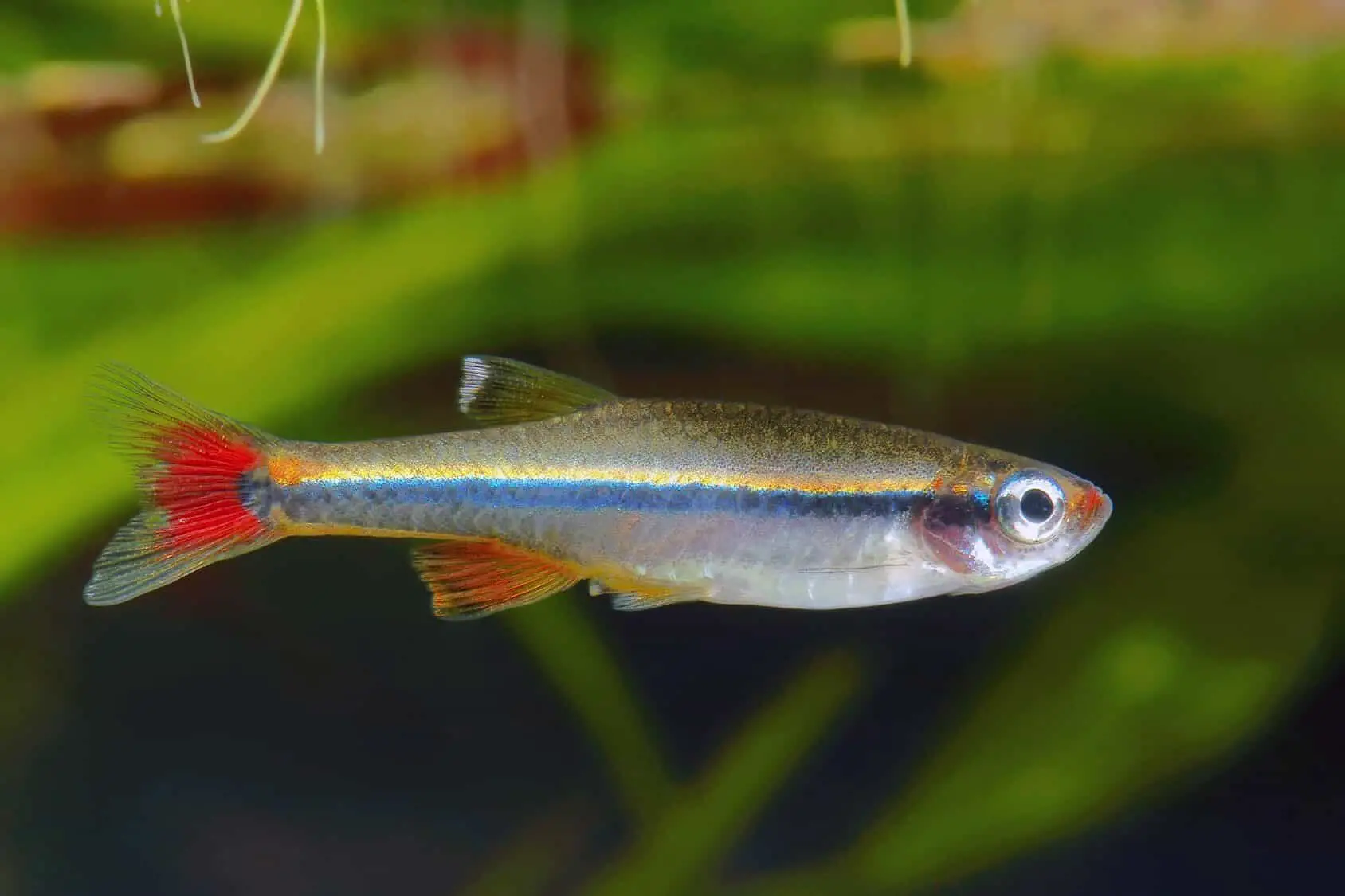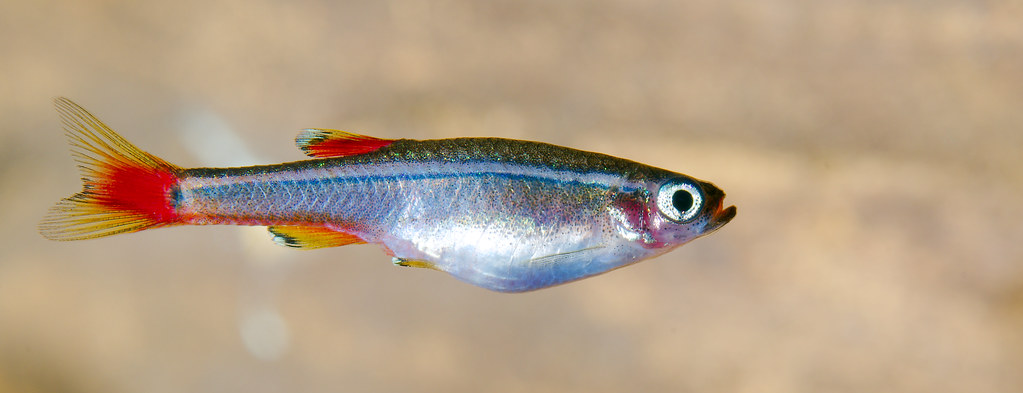White Cloud Minnow
The White Cloud Mountain Minnow, Tanichthys albonubes or more commonly known as the white cloud minnow, is an ideal choice for beginner aquarists. Boasting an appealing look, these fish are simple to look after and do not necessitate extensive equipment for upkeep.
- Experience Level: Beginner
- Hardiness: Hardy
- Minimum Tank Size: 20 gal (75 L) (for a school)
- Maximum Size: 2 inches (5 cm)
- Temperament: Peaceful
- Temperature: 61 – 72° F (16 – 22° C)
- pH Range: 6 – 8
- Water Hardness: 5 – 19 dGH
- Diet: Omnivore
Table of Contents
Introduction
Size and Appearance
Care Guide
Tank Mates
Diet and Feeding
Breeding
Although they bear resemblance to the tetra family, occasionally being marketed as White Cloud Tetra, their real lineage is from the carp family, and they appreciate cooler water conditions. They are popularly opted for in aquariums and sometimes in ponds for control of mosquito larvae.
Originating from China, the White Cloud Minnow is named after the White Cloud Mountain in Guangdong province, where it was first discovered in the 1930s. These days, due to overfishing and industrial pollution, it is almost extinct in its native habitat. However its captive-bred variant is widely available for fish keepers. Their captivating colors and adaptable nature make them an ideal choice for many.
Size and Appearance
White Clouds are a schooling fish that function best in a group of at least five. Isolated or unhealthy fishes often lose their color. These slender fish grow up to 1.5 inches and have a body color ranging from silver to light bronze, with bright red on their caudal fin and tail.
Their overall appearance features a darker back with bronze to blue shades, light undersides, and a lengthwise blue-green iridescent stripe. Owing to selective breeding, you can find color variations among them with golden or red tones.
Sexual dimorphism in this species is noticeable through differences in color and body shape. Females typically have a more subdued color and a round belly, especially when gravid, along with wedge-shaped fins. Males, on the other hand, flaunt vibrant colors and longer, fan-shaped fins.
With proper care, White Cloud Minnows can live for an average of 5 to 7 years. They tend to have longer life spans when kept at mid to lower temperature ranges.
Care Guide
- Minimum Tank Size: 20 gal (75 L) (for a school)
- pH Range: 6 – 8
- Water Hardness: 5 – 19 dGH
- Temperature: 61 – 72° F (16 – 22° C)
- Lighting: Moderate, diffused lighting
- Substrate: Fine sand/gravel
- Brackish: No
- Water Flow: Weak/Low
- Tank Region: Mid to upper
White Cloud Minnows are one of the most manageable species for aquarists. Even a small two-gallon desk aquarium is enough for them, yet they can coexist happily with multiple species in larger settings. You can comfortably house several dozen of them in a standard 10-gallon aquarium.
They demand simple conditions such as water temperature between 61°-72°F (or 18-22°C) and a chlorine-free environment. Implementing a good filtration system and maintaining water temperature on the lower to middle end of the given range will ensure healthier and more vibrantly colored fish. An under-gravel filter will induce water movement which they enjoy.
The lighting in your aquarium is dictated by the type of plants you wish to grow. Lower light makes your White Cloud Minnows more active, while an aquarium black light enhances their iridescent characteristics.
Their natural habitats consist of rocky gravel bottoms and considerable vegetation. Designing their environment with aquarium gravel and bottom features such as driftwood and rocks can replicate this. Plants provide them with areas to explore, hide, and lay eggs. Both live and artificial plants can be included.
It’s important to select plants that can survive in their desired temperature range and aren’t excessively fast-growing. Avoid using fertilizers for the aquatic plants as it may cause abrupt alterations in water chemistry which can be detrimental to your fish.
Tank Mates
White Cloud Minnows coexist peacefully with similar sized, non-aggressive fishes. Selecting small, non-hostile species that can withstand cooler waters has proved to be a challenge. Consider pairing them with other species that enjoy cooler waters, such as shrimp, danios, and smaller killifish.
Feeding Guide
- Diet: Omnivore
- Frequency: Several small feedings per day
- Pellet Foods: Yes
- Flake Foods: Yes
- Live Foods: Yes
- Meat Foods: Yes
- Vegetable Foods: Yes
White Cloud Minnows are omnivorous by nature and can comfortably thrive on flaked or pelletized tropical fish food. They will also nibble the leaves of any live plants in the aquarium. Their diet should be varied to prevent them from losing interest in any particular food.
As they are rather introverted in nature, they might have trouble competing for food with middle or lower dwelling tank mates. Therefore, feeding them twice a day in small quantities is recommended for keeping them active.
Maintain a balanced and varied diet and you will have a school of active and happy White Cloud Minnows.
Breeding
White Cloud Minnows are an ideal species for beginners with an interest in fish breeding. Little needs to be done to trigger their reproduction except for maintaining a healthy male to female ratio and an ample amount of vegetation for laying eggs.
Males indulge in some mating rituals before the actual process of spawning; this includes fluttering their fins near the females and chasing them. The preferred location for egg-laying is the vegetation, which is why Java Moss and Water Sprite are suggested.
White Cloud Minnow eggs hatch within a span of 48 to 60 hours and the newborns are self-sufficient from birth, surviving on fine powdered fish flakes. Luckily, the adults don’t prey on the juveniles, allowing you to keep them all in the same aquarium. The juveniles are fast growers and reach near full size quite quickly, hence population control is crucial to prevent overcrowding.



